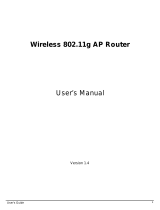
1
Chapter 1: Introduction
Welcome
Wireless-G Broadband Router with SpeedBooster
Chapter 1: Introduction
Welcome
Thank you for choosing the Linksys Wireless-G Broadband Router with SpeedBooster. The Wireless-G Broadband
Router with SpeedBooster will allow you to network wirelessly better than ever, sharing Internet access, files and
fun, easily and securely.
How does the Wireless-G Broadband Router with SpeedBooster do all of this? A router is a device that allows
access to an Internet connection over a network. With the Wireless-G Broadband Router with SpeedBooster, this
access can be shared over the four switched ports and via the wireless network, broadcast at either 11Mbps for
Wireless-B or 54Mbps for Wireless-G. In addition, WEP encryption provides greater security opportunities while
the whole network is protected through a Stateful Packet Inspection (SPI) firewall and NAT technology. All of
these security features, as well as full configurability, are accessed through the easy-to-use browser-based
utility.
But what does all of this mean?
Networks are useful tools for sharing computer resources. You can access one printer from different computers
and access data located on another computer's hard drive. Networks are even used for playing multiplayer video
games. So, networks are not only useful in homes and offices, they can also be fun.
PCs on a wired network create a Local Area Network. They are connected with Ethernet cables, which is why the
network is called “wired”.
PCs equipped with wireless cards or adapters can communicate without cumbersome cables. By sharing the
same wireless settings, within their transmission radius, they form a wireless network. The Wireless-G
Broadband Router with SpeedBooster bridges wireless networks of both 802.11b and 802.11g standards and
wired networks, allowing them to communicate with each other. And since this Router has SpeedBooster
technology, your wireless network performance increases by up to 30% from old 802.11g standards. In fact, even
non-SpeedBooster-equipped devices on your network will see a speed improvement when communicating with
SpeedBooster-enhanced equipment!
With your networks all connected, wired, wireless, and the Internet, you can now share files and Internet
access—and even play games. All the while, the Wireless-G Broadband Router with SpeedBooster protects your
networks from unauthorized and unwelcome users.
You should always use the Setup CD-ROM when you first install the Router. If you do not wish to run the Setup
Wizard on the Setup CD-ROM, then use the instructions in this Guide to help you connect the Wireless-G
Broadband Router with SpeedBooster, set it up, and configure it to bridge your different networks. These
instructions should be all you need to get the most out of the Wireless-G Broadband Router with SpeedBooster.





















